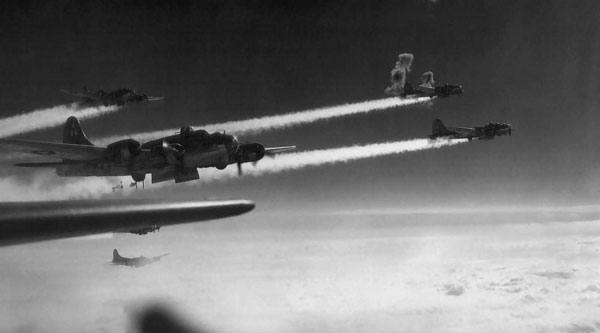These German soldiers stand in the debris strewn street of Bastogne, Belgium, on January 9, 1945, after they were captured by the U.S. 4th Armored Division that helped break the German siege of the city.
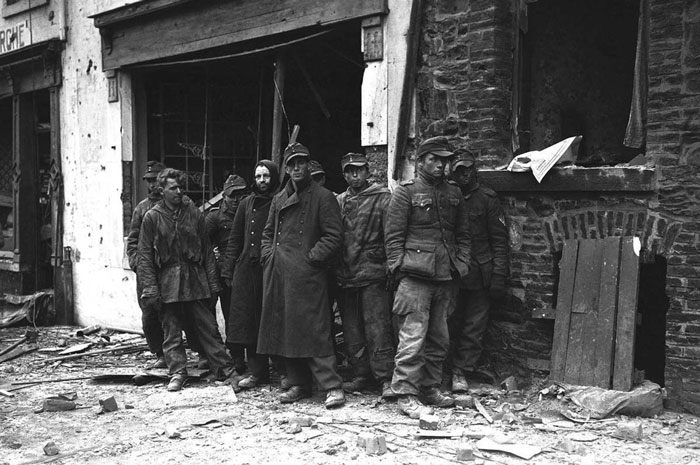
Photo credit: Library of Congress / AP Photo
By the beginning of 1945, the brutal war that Nazi Germany had unleashed throughout the world had come back to haunt them.
The Germans tried to hold out their position, although at this time they knew the inevitable outcome. But they did not give up even when the Russian soldiers arrived in the garden of the Reich Chancellery in Berlin. Even the Japanese did not show resistance like that.
By March, Western Allied forces were capturing hundreds of thousands of troops from Germany’s Army Group B. The Red Army had meanwhile entered Austria, and both fronts quickly approached Berlin. Strategic bombing campaigns by Allied aircraft were pounding German territory, destroying entire cities in a night.
The Germans put up a fierce defense, but catastrophic defeat was inevitable after they ran out of supplies, and exhausted its options. Allied forces pushed through the German defensive like a juggernaut.
On April 30th, as the Russians entered the outskirts of Berlin, Adolf Hitler committed suicide.
The leadership of Nazi Germany was passed to Joseph Goebbels, but within 24 hours he too took his own life.
Other Nazi leaders were either captured or running like fugitives. The Nazi Germany surrender came on May 7, 1945. The once too proud, loud and boastful Nazism movement of the 1930s was drawing its final breaths. Their ultimate legacy was a war that had claimed the lives of more than 48 million people, a genocide unheard of in human history, and a devastated Germany, occupied by her enemies and torn apart for decades to come.
“Raising a flag over the Reichstag” the famous photograph by Yevgeny Khaldei, taken on May 2, 1945. The photo shows Soviet soldiers raising the flag of the Soviet Union on top of the German Reichstag building following the Battle of Berlin. The moment was actually a re-enactment of an earlier flag-raising, and the photo was embroiled in controversy over the identities of the soldiers, the photographer, and some significant photo editing.
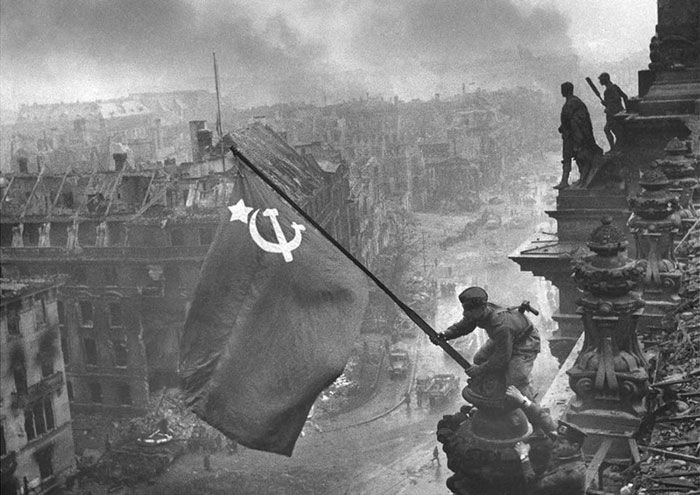
Photo credit: Library of Congress / AP Photo
A group of Hitler youth receive instruction in the use of a machine-gun, somewhere in Germany, on December 27, 1944.
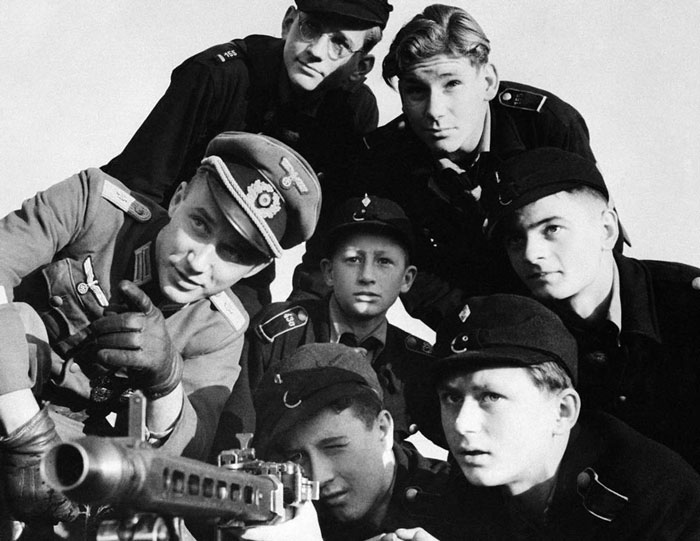
Photo credit: Library of Congress / AP Photo
A formation of B-24s of Maj. General Nathan F. Twining’s U.S. Army 15th Air Force thunders over the railway yards of Salzburg, Austria, on December 27, 1944. The smoke created by their bombs mingles with that from the enemy’s many smudge pots.
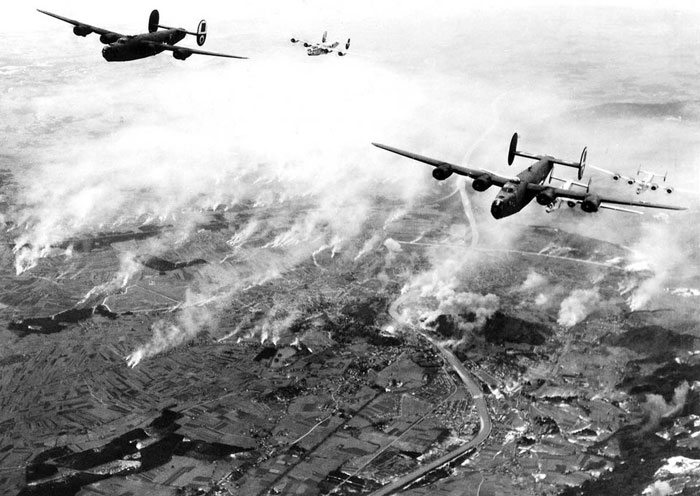
Photo credit: Library of Congress / AP Photo
A heavily armed German soldier carries ammunition boxes forward during the German counter-offensive in the Belgium-Luxembourg salient, on January 2, 1945.
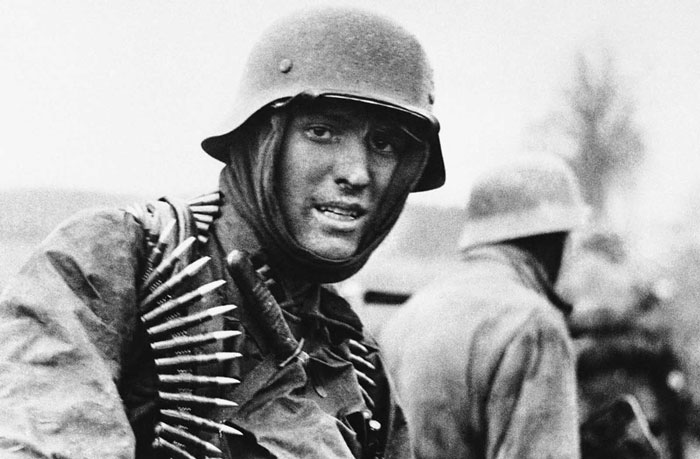
Photo credit: Library of Congress / AP Photo
An infantryman from the U.S. Army’s 82nd Airborne Division goes out on a one-man sortie while covered by a comrade in the background, near Bra, Belgium, on December 24, 1944.
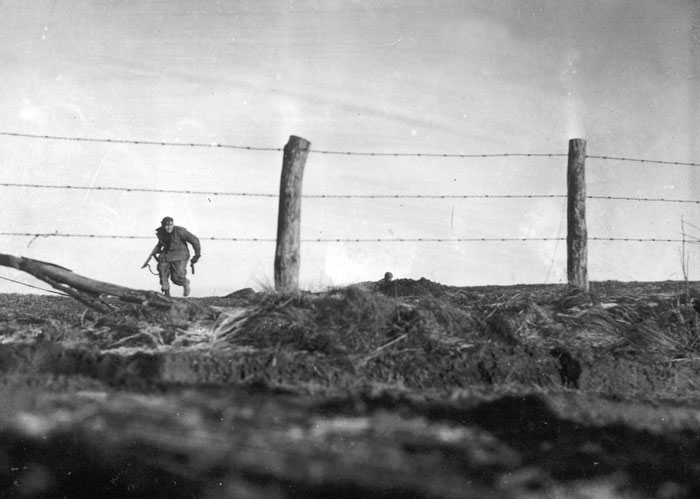
Photo credit: Library of Congress / AP Photo
A Soviet machine gun crew crosses a river along the second Baltic front, in January of 1945. The soldier on the left is holding his rifle overhead while his comrades push a floating device with the artillery gun forward, followed by two men with several supply boxes.
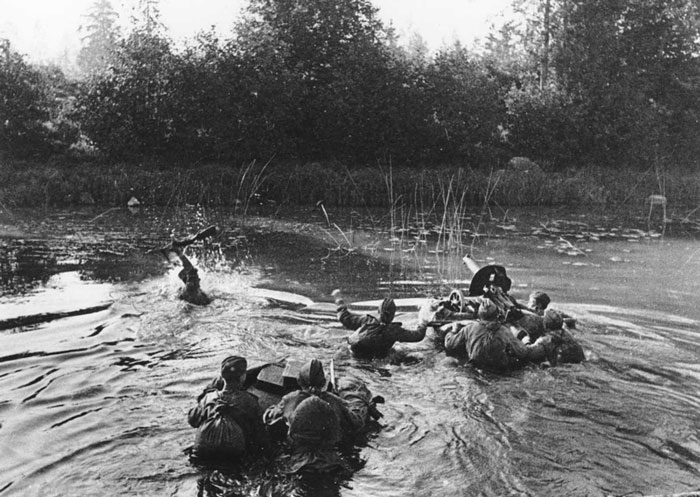
Photo credit: Library of Congress / AP Photo
Low flying C-47 transport planes roar overhead as they carry supplies to the besieged American Forces battling the Germans at Bastogne, during the enemy breakthrough on January 6, 1945 in Belgium. In the distance, smoke rises from wrecked German equipment, while in the foreground, American tanks move up to support the infantry in the fighting.
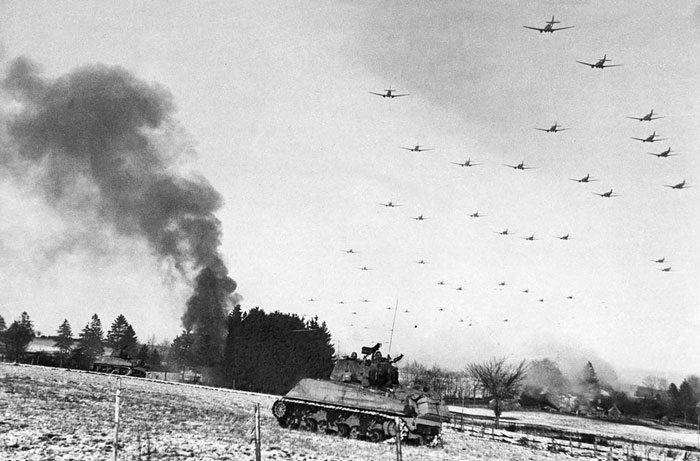
Photo credit: Library of Congress / AP Photo
Refugees stand in a group in a street in La Gleize, Belgium on January 2, 1945, waiting to be transported from the war-torn town after its recapture by American Forces during the German thrust in the Belgium-Luxembourg salient.
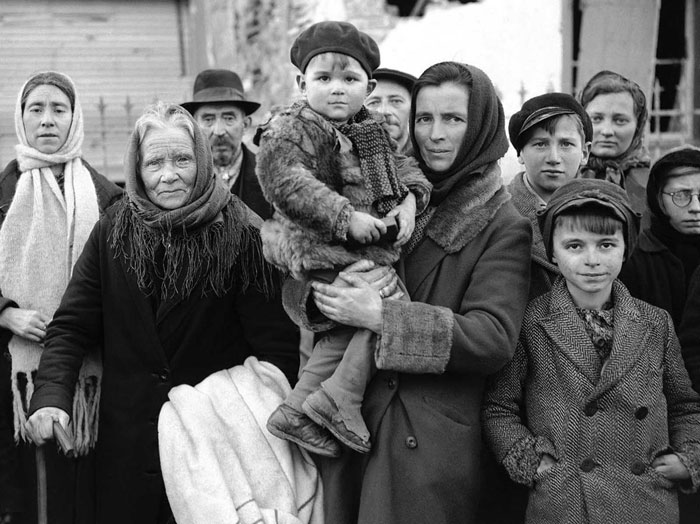
Photo credit: Library of Congress / AP Photo
A dead German soldier, killed during the German counter offensive in the Belgium-Luxembourg salient, is left behind on a street corner in Stavelot, Belgium, on January 2, 1945, as fighting moves on during the Battle of the Bulge.
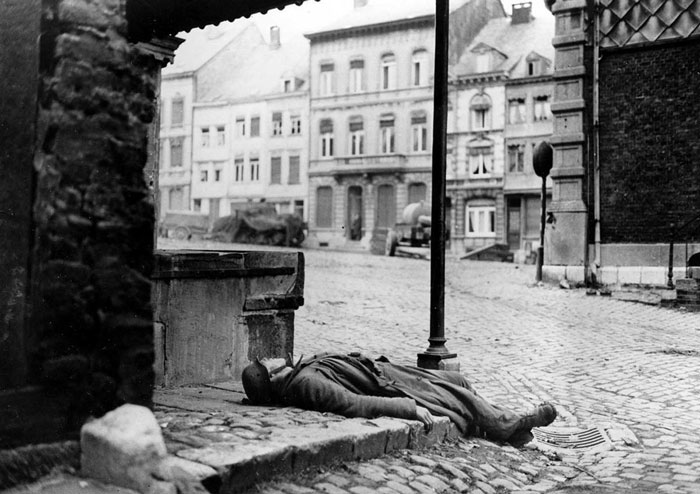
Photo credit: Library of Congress / AP Photo
From left, British Prime Minister Winston Churchill, U.S. President Franklin Roosevelt and Soviet Premier Josef Stalin sit on the patio of Livadia Palace, Yalta, Crimea, in this February 4, 1945 photo. The three leaders were meeting to discuss the post-war reorganization of Europe, and the fate of post-war Germany.
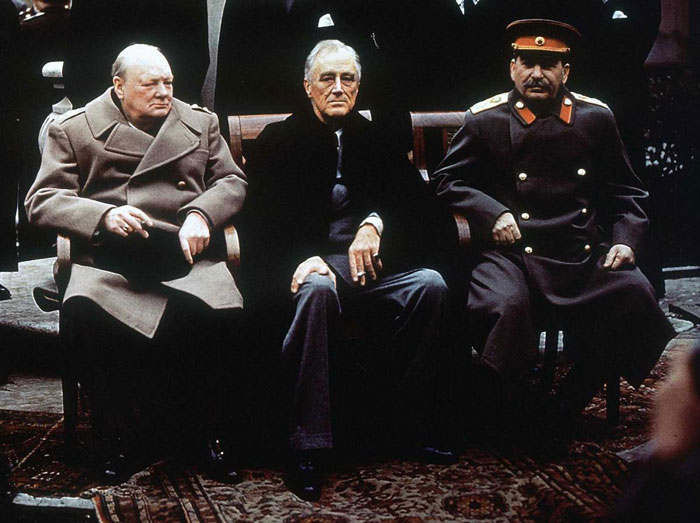
Photo credit: Library of Congress / AP Photo
Soviet troops of the 3rd Ukrainian front in action amid the buildings of the Hungarian capital on February 5, 1945.
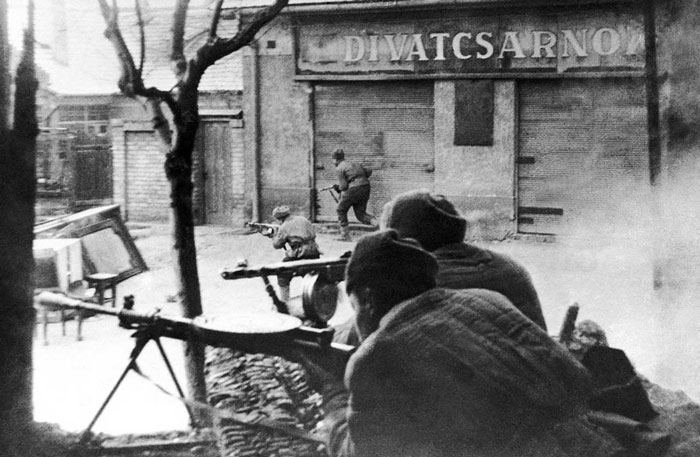
Photo credit: Library of Congress / AP Photo
Across the Channel, Britain was being struck by continual bombardment by thousands of V-1 and V-2 bombs launched from German-controlled territory. This photo, taken from a fleet street roof-top, shows a V-1 flying bomb “buzzbomb” plunging toward central London. The distinctive sky-line of London’s law-courts clearly locates the scene of the incident. Falling on a side road off Drury Lane, this bomb blasted several buildings, including the office of the Daily Herald. The last enemy action of British soil was a V-1 attack that struck Datchworth in Hertfordshire, on March 29 1945.
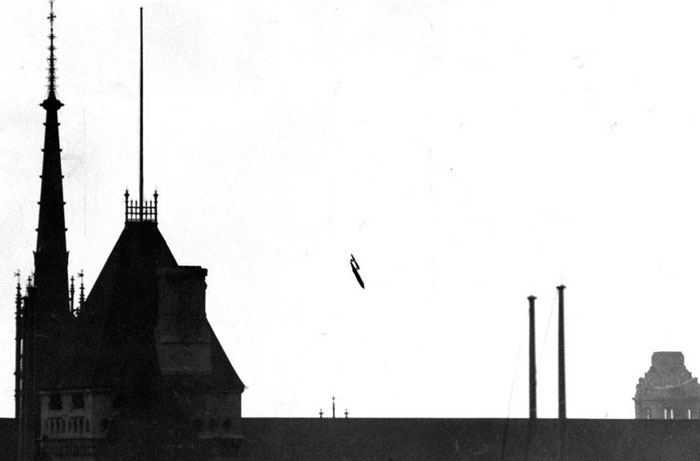
Photo credit: Library of Congress / AP Photo
With more and more members of the Volkssturm (Germany’s National Militia) being directed to the front line, German authorities were experiencing an ever-increasing strain on their stocks of army equipment and clothing. In a desperate attempt to overcome this deficiency, street to street collection depots called the Volksopfer, meaning Sacrifice of the people, scoured the country, collecting uniforms, boots and equipment from German civilians, as seen here in Berlin on February 12, 1945. The Volksopfer bears the words “The Fuhrer expects your sacrifice for Army and Home Guard. So that you’re proud your Home Guard man can show himself in uniform – empty your wardrobe and bring its contents to us”.
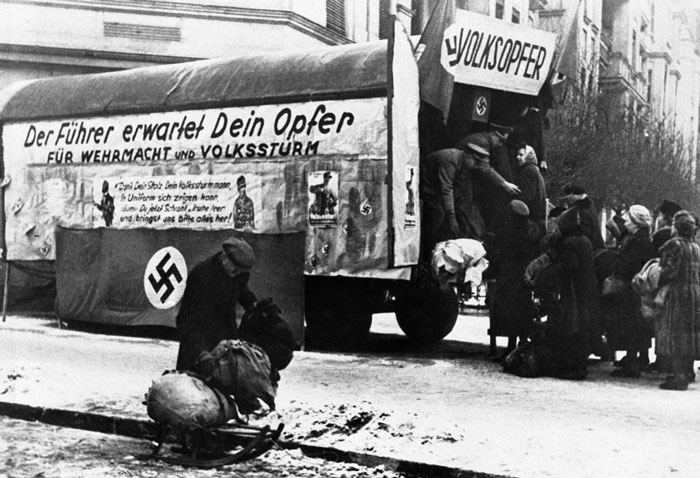
Photo credit: Library of Congress / AP Photo
A party sets out to repair telephone lines on the main road in Kranenburg on February 22, 1945, amid four-foot deep floods caused by the bursting of Dikes by the retreating Germans. During the floods, British troops further into Germany have had their supplies brought by amphibious vehicles.
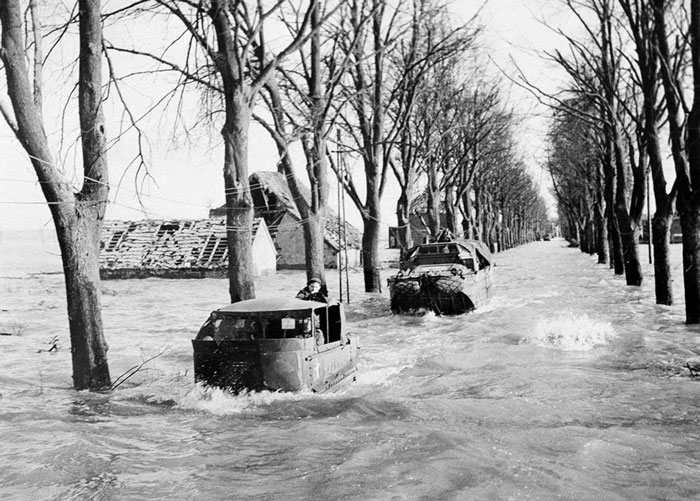
Photo credit: Library of Congress / AP Photo
This combination of three photographs shows the reaction of a 16-year old German soldier after he was captured by U.S. forces, at an unknown location in Germany, in 1945.
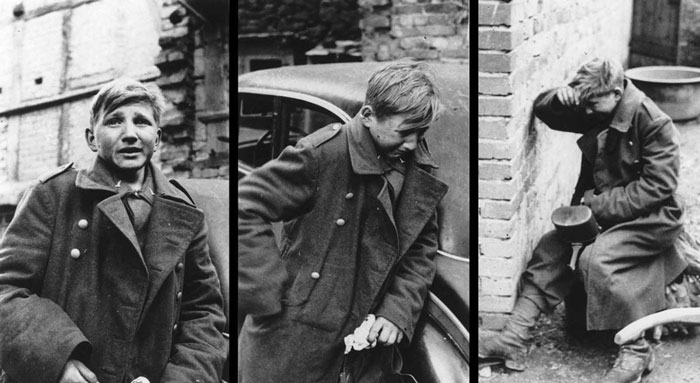
Photo credit: Library of Congress / AP Photo
Flak bursts through the vapor trails from B-17 flying fortresses of the 15th air force during the attack on the rail yards at Graz, Austria, on March 3, 1945.
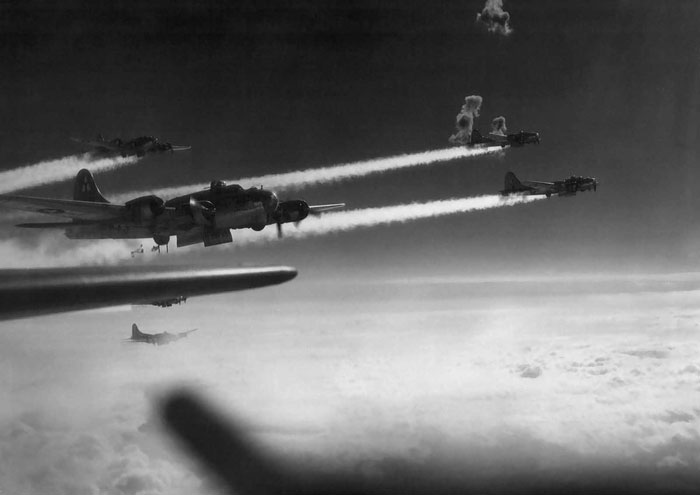
Photo credit: Library of Congress / AP Photo
A view taken from Dresden’s town hall of the destroyed Old Town after the allied bombings between February 13 and 15, 1945. Some 3,600 aircraft dropped more than 3,900 tons of high-explosive bombs and incendiary devices on the German city. The resulting firestorm destroyed 15 square miles of the city center, and killed more than 22,000.
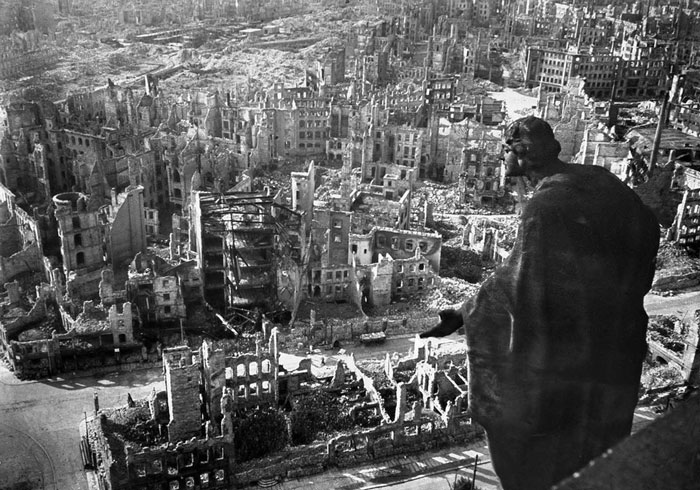
Photo credit: Library of Congress / AP Photo
Soldiers of the 3rd U.S. Army storm into Coblenz, Germany, as a dead comrade lies against the wall, on March 18, 1945.
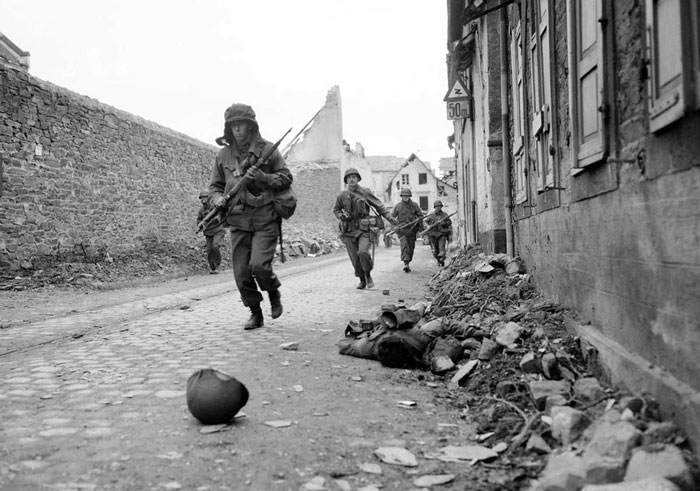
Photo credit: Library of Congress / AP Photo
Men of the American 7th Army pour through a breach in the Siegfried Line defenses, on their way to Karlsruhe, Germany on March 27, 1945, which lies on the road to Stuttgart.
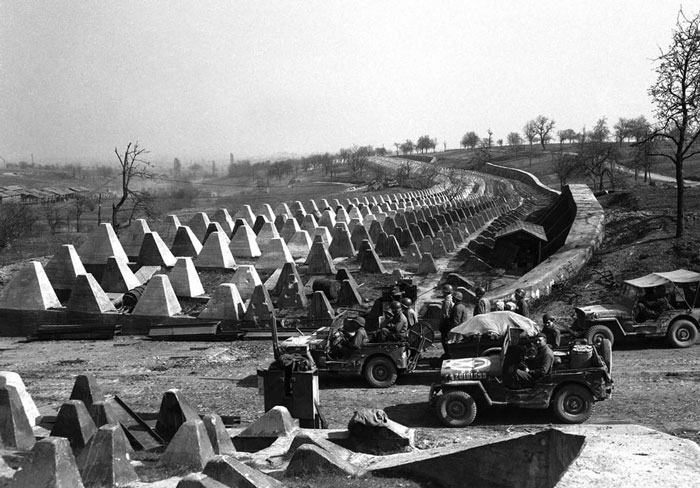
Photo credit: Library of Congress / AP Photo
Pfc. Abraham Mirmelstein of Newport News, Virginia, holds the Holy Scroll as Capt. Manuel M. Poliakoff, and Cpl. Martin Willen, of Baltimore, Maryland, conduct services in Schloss Rheydt, former residence of Dr. Joseph Paul Goebbels, Nazi propaganda minister, in Münchengladbach, Germany on March 18, 1945. They were the first Jewish services held east of the Rur River and were offered in memory of soldiers of the faith who were lost by the 29th Division, U.S. 9th Army.
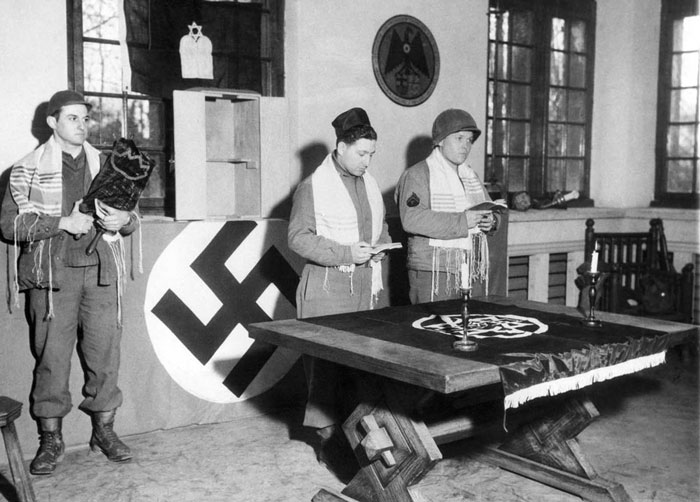
Photo credit: Library of Congress / AP Photo
American soldiers aboard an assault boat huddle together as they cross the Rhine river at St. Goar, Germany, while under heavy fire from the German forces, in March of 1945.
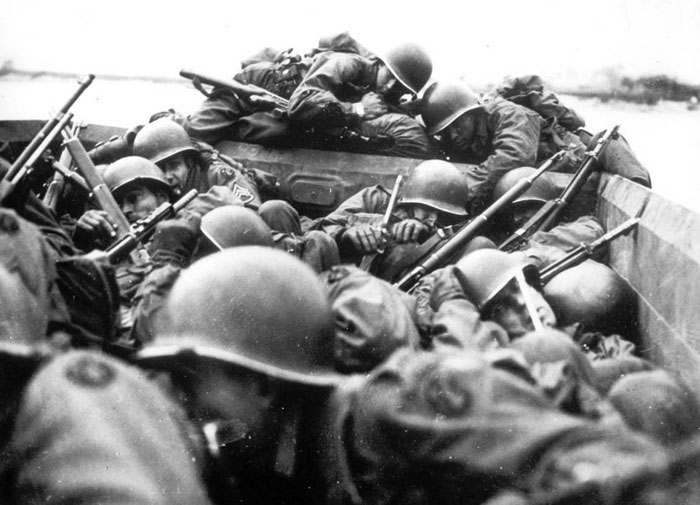
Photo credit: Library of Congress / AP Photo
An unidentified American soldier, shot dead by a German sniper, clutches his rifle and hand grenade in March of 1945 in Coblenz, Germany.
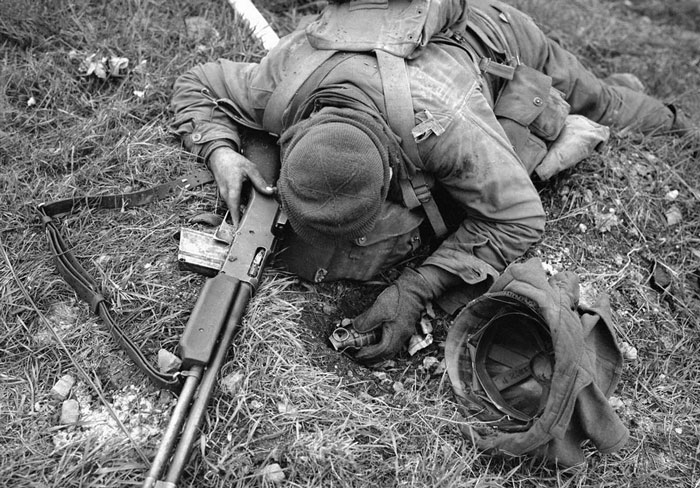
Photo credit: Library of Congress / AP Photo
War-torn Cologne Cathedral stands out of the devastated area on the west bank of the Rhine, in Cologne, Germany, April 24, 1945. The railroad station and the Hohenzollern Bridge, at right, are completely destroyed after three years of Allied air raids.
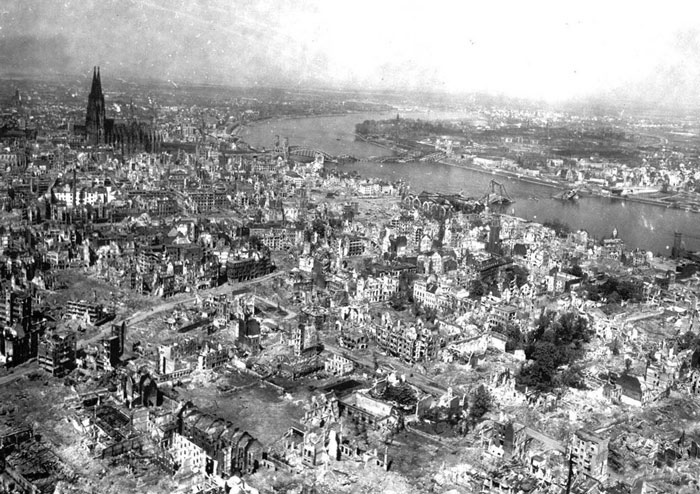
Photo credit: Library of Congress / AP Photo
An American soldier of the 12th Armored Division stands guard over a group of German soldiers, captured in April 1945, in a forest at an unknown location in Germany.
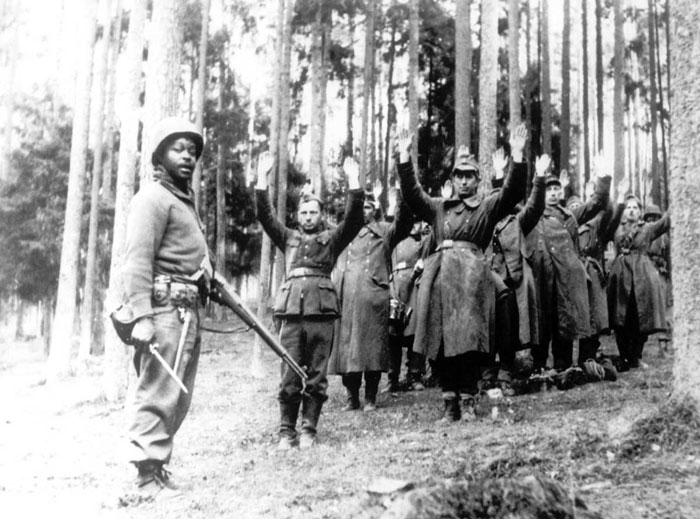
Photo credit: Library of Congress / AP Photo
Adolf Hitler decorates members of his Nazi youth organization “Hitler Jugend” in a photo reportedly taken in front of the Chancellery Bunker in Berlin, on April 25, 1945. That was just four days before Hitler committed suicide.
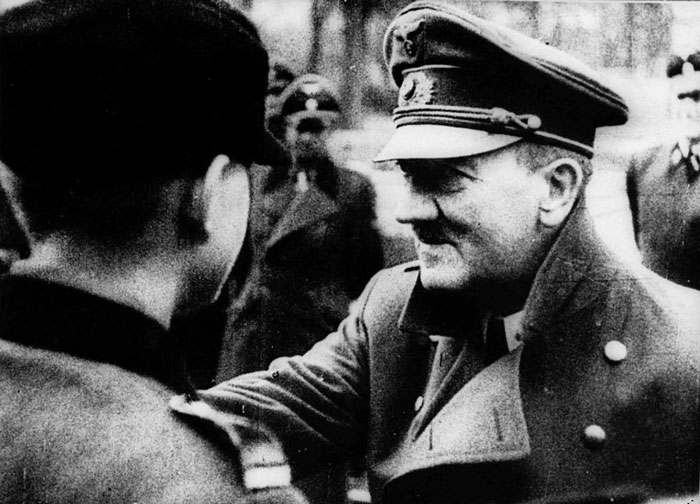
Photo credit: Library of Congress / AP Photo
Partly completed Heinkel He-162 fighter jets sit on the assembly line in the underground Junkers factory at Tarthun, Germany, in early April 1945. The huge underground galleries, in a former salt mine, were discovered by the 1st U.S. Army during their advance on Magdeburg.
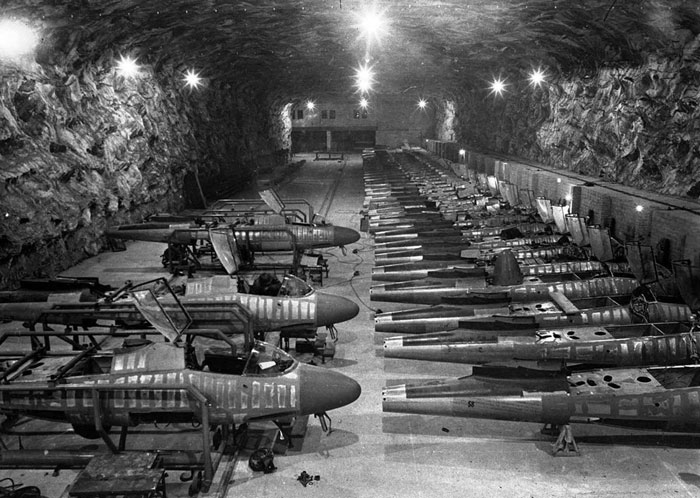
Photo credit: Library of Congress / AP Photo
Soviet officers and U.S. soldiers during a friendly meeting on the Elbe River in April of 1945.
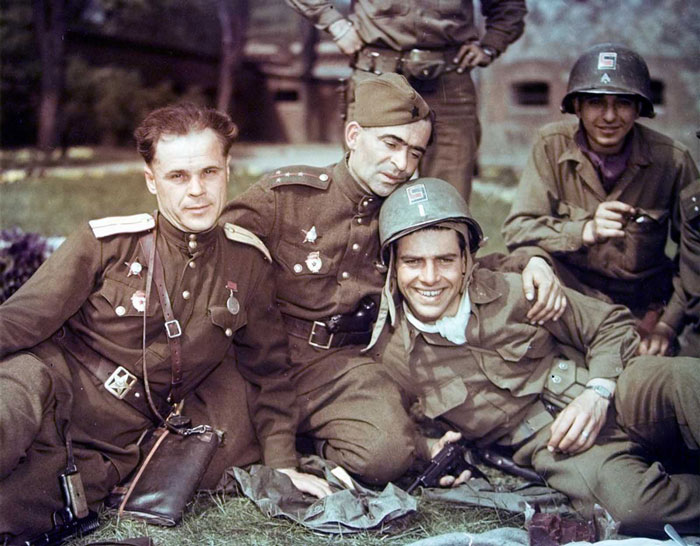
Photo credit: Library of Congress / AP Photo
Compounds erected by the Allies for their collections of prisoners never seem to be big enough, here is an over-crowded cage of Germans rounded up by the Seventh Army during its drive to Heidelberg, on April 4, 1945.
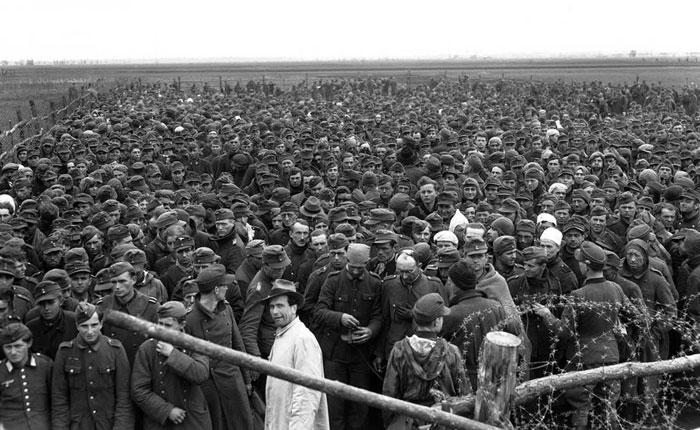
Photo credit: Library of Congress / AP Photo
A U.S. soldier stands in the middle of rubble in the Monument of the Battle of the Nations in Leipzig after they attacked the city on April 18, 1945. The huge monument commemorating the defeat of Napoleon in 1813 was one of the last strongholds in the city to surrender. One hundred and fifty SS fanatics with ammunition and foodstuffs stored in the structure to last three months dug themselves in and were determined to hold out as long as their supplies. American First Army artillery eventually blasted the SS troops into surrender.
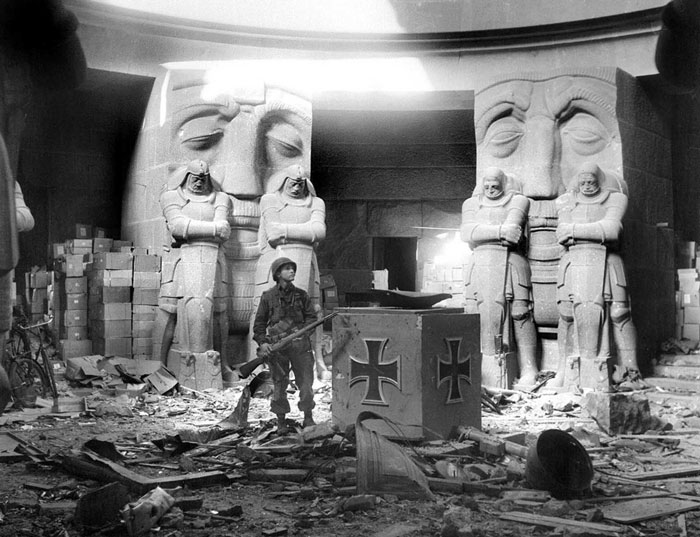
Photo credit: Library of Congress / AP Photo
Soviet soldiers lead house-to-house fighting in the outskirts of Königsberg, East Prussia, Germany, in April of 1945.
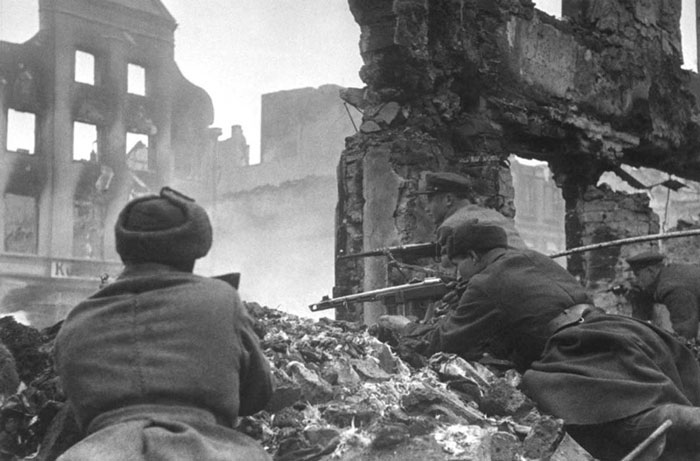
Photo credit: Library of Congress / AP Photo
A German officer eats C-rations as he sits amid the ruins of Saarbrücken, a German city and stronghold along the Siegfried Line, in early spring of 1945.
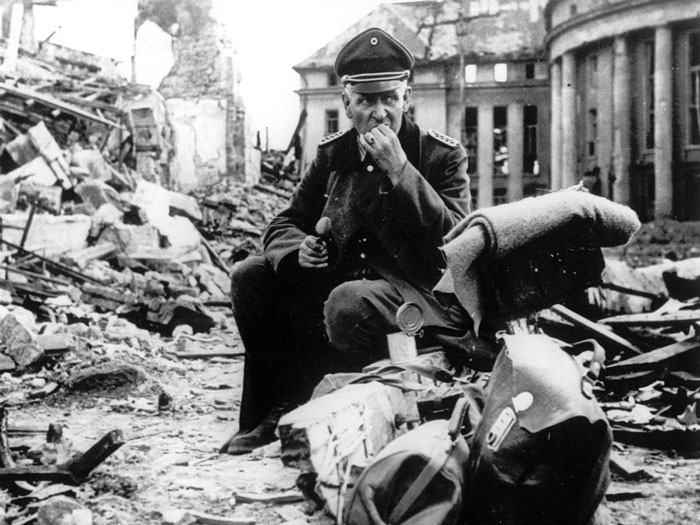
Photo credit: Library of Congress / AP Photo
Overwhelmed with emotion, this Czech mother kisses a Russian soldier in Prague, Czech Republic on May 5, 1945, thanking one who fought to free her beloved home.
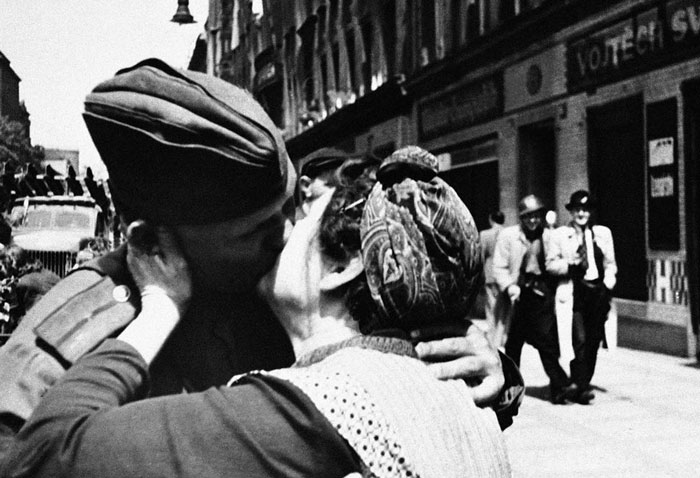
The subway rush hour is brought to a standstill in New York City, May 1, 1945 as the report of Hitler’s death was received. The German leader and head of the Nazi Party had shot himself in the head in a bunker in Berlin on April 30, 1945. His successor, Karl Dönitz, announced on German radio that Hitler had died the death of a hero, and that he would continue the war against the Allies.
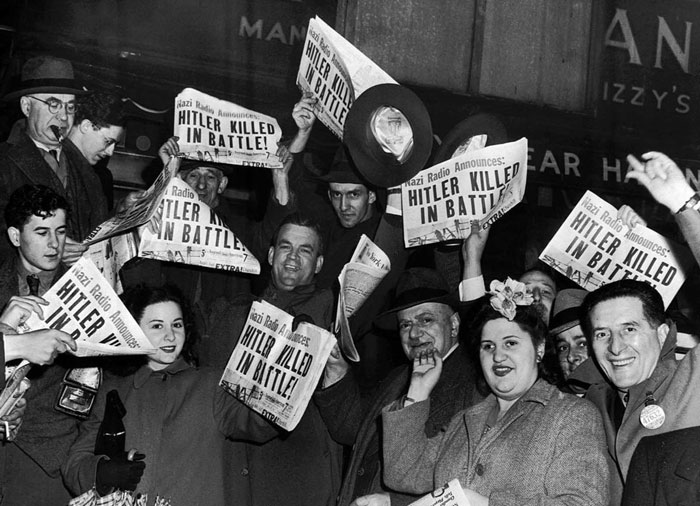
Photo credit: Library of Congress / AP Photo
Britain’s Field Marshal Bernard Montgomery, right, reads over the surrender pact, while senior German officers, from left, Major Friedel, Rear Admiral Wagner and Admiral Hans-Georg Von Friedeburg, look on, in a tent at Montgomery’s 21st Army Group headquarters, at Luneburg Heath, on May 4, 1945. The pact agreed a ceasefire on the British fronts in north west Germany, Denmark and Holland as from 8am on May 5. German forces in Italy had surrendered earlier, on April 29, and the remainder of the the Army in Western Europe surrendered on May 7 — on the Eastern Front, the German surrender to the Soviets took place on May 8, 1945. More than five years of horrific warfare on European soil was officially over.
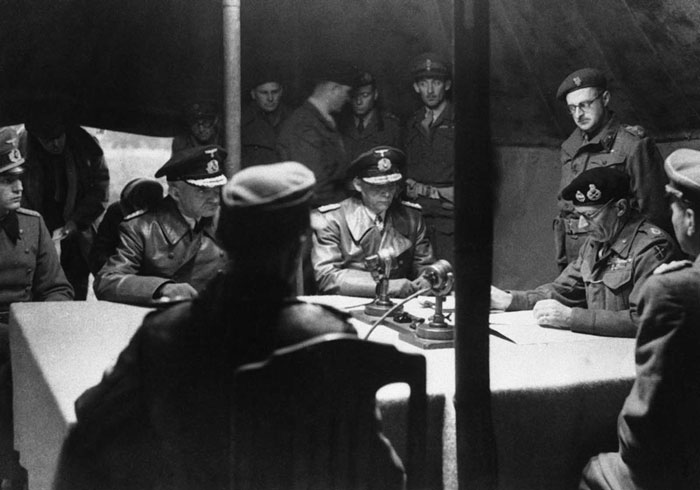
Photo credit: Library of Congress / AP Photo
A seething mass of humanity jammed itself into Whitehall in central London on VE-Day (Victory in Europe Day), May 8, 1945, to hear the premier officially announce Germany’s unconditional surrender. More than one million people celebrated in the streets of London.
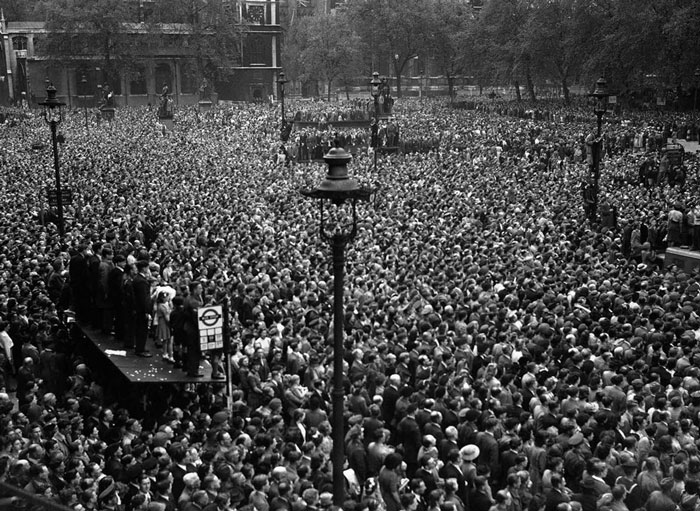
Photo credit: Library of Congress / AP Photo
Looking north from 44th Street, New York’s Times Square is packed Monday, May 7, 1945, with crowds celebrating the news of Germany’s unconditional surrender in World War II.
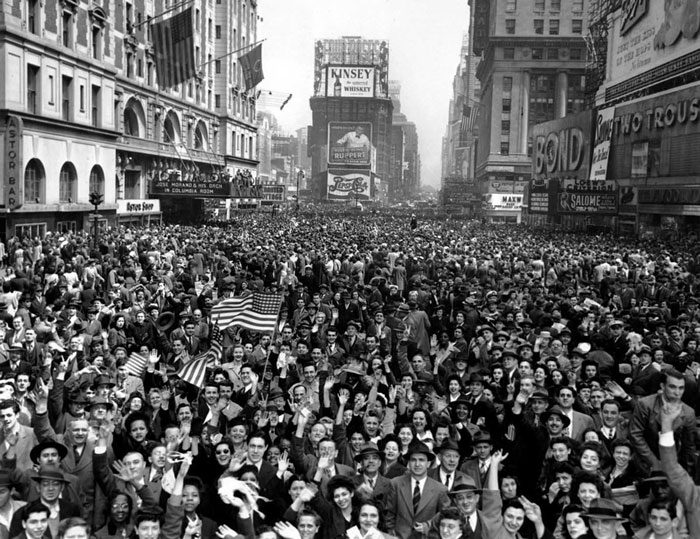
Photo credit: Library of Congress / AP Photo
Celebration of Victory in Moscow’s Red Square, in the Soviet Union. Fireworks began on May 9, 1945, followed by bursts of gunfire and a sky illuminated by searchlights.
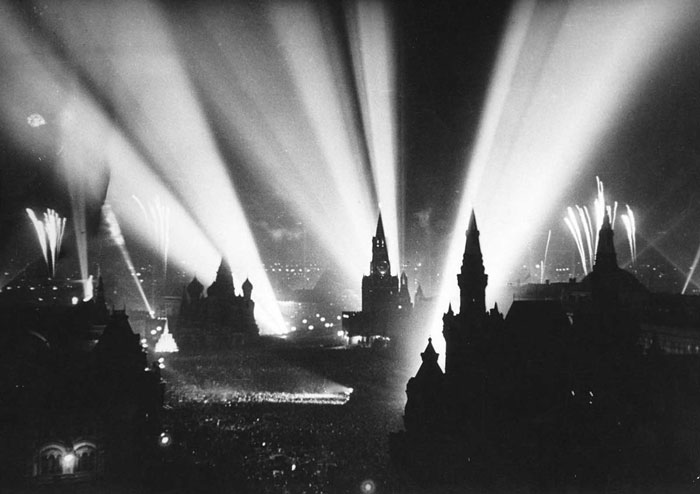
Photo credit: Library of Congress / AP Photo
The wrecked Reichstag building in Berlin, Germany, with a destroyed German military vehicle in the foreground, at the end of World War II.
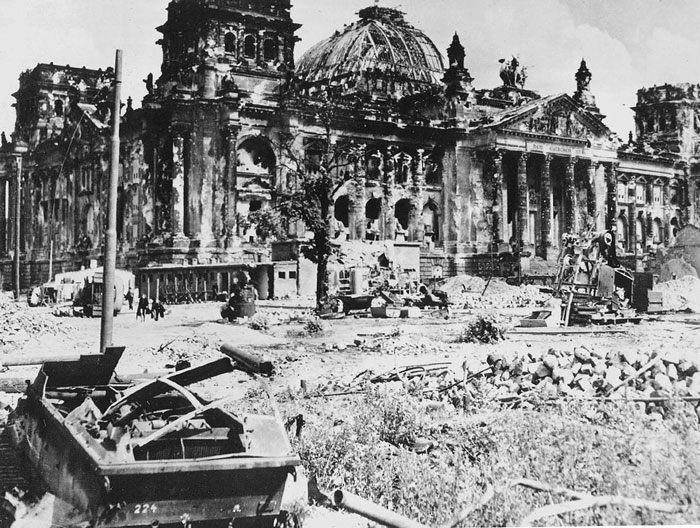
Photo credit: Library of Congress / AP Photo
Soviet Ilyushin Il-2 ground attack aircraft fly in the skies above Berlin, Germany in 1945.
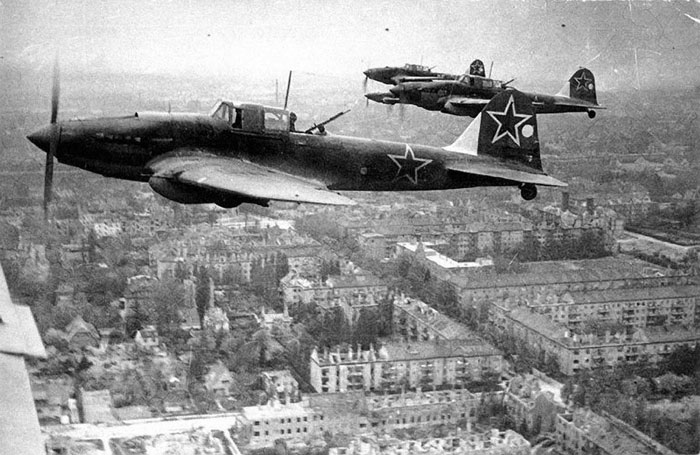
Photo credit: Library of Congress / AP Photo
A color photograph of the bombed-out historic city of Nuremberg, Germany in June of 1945, after the end of World War II. Nuremberg had been the host of huge Nazi Party conventions from 1927 to 1938. The last scheduled rally in 1939 was canceled at the last minute due to a scheduling conflict: the German invasion of Poland one day prior to the rally date. The city was also the birthplace of the Nuremberg Laws, a set of draconian antisemitic laws adopted by Nazi Germany. Allied bombings from 1943 until 1945 destroyed more than 90% of the city center, and killed more than 6,000 residents. Nuremberg would soon become famous one last time as the host of the Nuremberg Trials — a series of military tribunals set up to prosecute the surviving leaders of Nazi Germany. The war crimes these men were charged with included “Crimes Against Humanity”, the systematic murder of more than 10 million people, including some 6 million Jews.
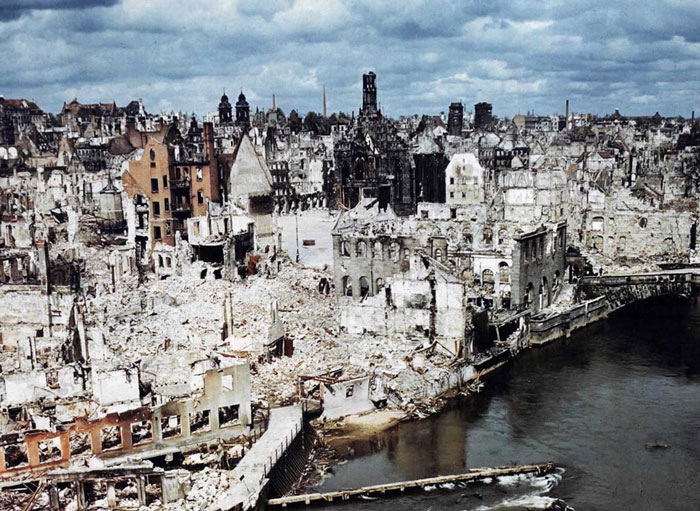
Photo credit: Library of Congress / AP Photo

